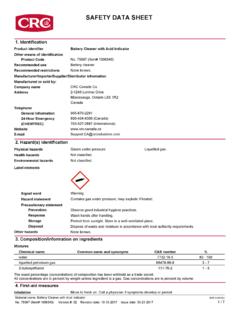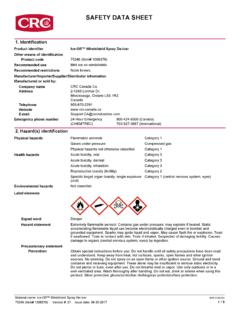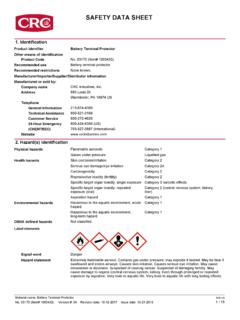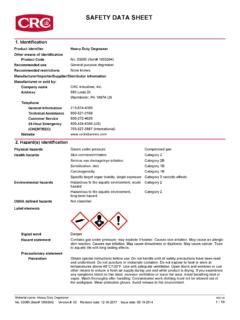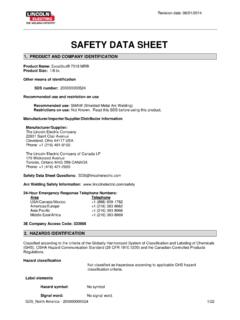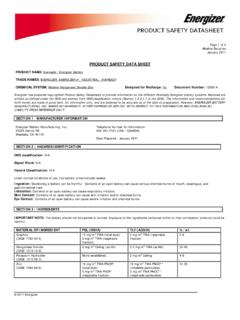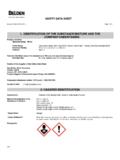Transcription of SAFETY DATA SHEET - CRC Industries
1 SAFETY data SHEET1. IdentificationGlass CleanerProduct identifierOther means of identificationNo. 73100 (Item# 1006176) product codeGlass cleanerRecommended useNone restrictionsManufacturer/Importer/Suppli er/Distributor informationManufactured or sold by:CRC Canada name2-1246 Lorimar DriveAddressMississauga, Ontario L5S 1R2 CanadaTelephone905-670-2291 General Information800-424-9300 (Canada)24-Hour Emergency703-527-3887 Hazard(s) identificationLiquefied gasGases under pressurePhysical hazardsNot hazardsCategory 3 Hazardous to the aquatic environment, acutehazardEnvironmental hazardsCategory 3 Hazardous to the aquatic environment,long-term hazardLabel elementsSignal wordWarningHazard statementContains gas under pressure; may explode if heated. Harmful to aquatic life with long statementPreventionObserve good industrial hygiene practices.
2 Avoid release to the hands after from sunlight. Store in a well-ventilated of contents/container in accordance with local/regional/national/international hazardsNone Composition/information on ingredientsMixturesCAS number%Chemical nameCommon name and synonyms7732-18-5water80 - 10068476-86-8liquefied petroleum gas3 - 7111-76-22-butoxyethanol1 - 564-17-5ethanol1 - 51 / 9 Material name: Glass CleanerNo. 73100 (Item# 1006176) Version #: 01 Issue date: 08-02-2016 SDS CANADACAS number%Chemical nameCommon name and - - 1 The exact percentage (concentration) of composition has been withheld as a trade concentrations are in percent by weight unless ingredient is a gas. Gas concentrations are in percent by First-aid measuresMove to fresh air. Call a physician if symptoms develop or off with soap and water.
3 Get medical attention if irritation develops and contactRinse with water. Get medical attention if irritation develops and contactRinse mouth. Get medical attention if symptoms contact with eyes may cause temporary importantsymptoms/effects, acute anddelayedProvide general supportive measures and treat of immediatemedical attention and specialtreatment neededEnsure that medical personnel are aware of the material(s) involved, and take precautions toprotect information5. Fire-fighting measuresWater fog. Foam. Dry chemical powder. Carbon dioxide (CO2).Suitable extinguishing mediaDo not use water jet as an extinguisher, as this will spread the extinguishingmediaContents under pressure. Pressurized container may rupture when exposed to heat or hazards arising fromthe chemicalFirefighters must use standard protective equipment including flame retardant coat, helmet withface shield, gloves, rubber boots, and in enclosed spaces, protective equipmentand precautions for firefightersIn case of fire: Stop leak if safe to do so.
4 Move containers from fire area if you can do so withoutrisk. Containers should be cooled with water to prevent vapor pressure build fightingequipment/instructions6. Accidental release measuresKeep people away from and upwind of spill/leak. Keep out of low areas. Wear appropriatepersonal protective equipment. Do not touch damaged containers or spilled material unlesswearing appropriate protective clothing. Ensure adequate ventilation. Local authorities should beadvised if significant spillages cannot be precautions,protective equipment andemergency proceduresStop the flow of material, if this is without risk. Wipe up with absorbent material ( cloth, fleece).Clean surface thoroughly to remove residual contamination. Prevent entry into waterways, sewer,basements or confined areas.
5 Following product recovery, flush area with and materials forcontainment and cleaning upAvoid discharge into drains, water courses or onto the ground. Do not contaminate precautions7. Handling and storagePressurized container: Do not pierce or burn, even after use. Keep away from heat/sparks/openflames/hot surfaces. - No smoking. Use caution around energized equipment. The metal containerwill conduct electricity if it contacts a live source. This may result in injury to the user from electricalshock and/or flash fire. Avoid prolonged exposure. Use with adequate ventilation. Open doors andwindows or use other means to ensure a fresh air supply during use and while product is appropriate personal protective equipment. Observe good industrial hygiene practices.
6 Forproduct usage instructions, see the product for safe handlingLevel 1 under pressure. Do not puncture or incinerate container. Do not expose to heat or storeat temperatures above 49 C/120 F. Store in a well-ventilated place. Store in a cool, dry place outof direct for safe storage,including any incompatibilities2 / 9 Material name: Glass CleanerNo. 73100 (Item# 1006176) Version #: 01 Issue date: 08-02-2016 SDS CANADA8. Exposure controls/personal protectionOccupational exposure limitsUS. ACGIH Threshold Limit ValuesValueComponentsTypeTWA20 ppm2-butoxyethanol (CAS111-76-2)STEL35 ppmammonia (CAS 7664-41-7)TWA25 ppmSTEL1000 ppmethanol (CAS 64-17-5)STEL250 ppmmethanol (CAS 67-56-1)TWA200 ppmCanada. Alberta OELs (Occupational Health & SAFETY Code, Schedule 1, Table 2)ValueComponentsTypeTWA97 mg/m32-butoxyethanol (CAS111-76-2)20 ppmSTEL24 mg/m3ammonia (CAS 7664-41-7)35 ppmTWA17 mg/m325 ppmTWA1880 mg/m3ethanol (CAS 64-17-5)1000 ppmSTEL328 mg/m3methanol (CAS 67-56-1)250 ppmTWA262 mg/m3200 ppmCanada.
7 British Columbia OELs. (Occupational Exposure Limits for Chemical Substances, Occupational Health andSafety Regulation 296/97, as amended)ValueComponentsTypeTWA20 ppm2-butoxyethanol (CAS111-76-2)STEL35 ppmammonia (CAS 7664-41-7)TWA25 ppmSTEL1000 ppmethanol (CAS 64-17-5)STEL250 ppmmethanol (CAS 67-56-1)TWA200 ppmCanada. Manitoba OELs (Reg. 217/2006, The Workplace SAFETY And Health Act)ValueComponentsTypeTWA20 ppm2-butoxyethanol (CAS111-76-2)STEL35 ppmammonia (CAS 7664-41-7)TWA25 ppmSTEL1000 ppmethanol (CAS 64-17-5)STEL250 ppmmethanol (CAS 67-56-1)TWA200 ppmCanada. Ontario OELs. (Control of Exposure to Biological or Chemical Agents)ValueComponentsTypeTWA20 ppm2-butoxyethanol (CAS111-76-2)STEL35 ppmammonia (CAS 7664-41-7)TWA25 ppmSTEL1000 ppmethanol (CAS 64-17-5)STEL250 ppmmethanol (CAS 67-56-1)TWA200 ppm3 / 9 Material name: Glass CleanerNo.
8 73100 (Item# 1006176) Version #: 01 Issue date: 08-02-2016 SDS CANADAC anada. Quebec OELs. (Ministry of Labor - Regulation Respecting the Quality of the Work Environment)ValueComponentsTypeTWA97 mg/m32-butoxyethanol (CAS111-76-2)20 ppmSTEL24 mg/m3ammonia (CAS 7664-41-7)35 ppmTWA17 mg/m325 ppmTWA1880 mg/m3ethanol (CAS 64-17-5)1000 ppmSTEL328 mg/m3methanol (CAS 67-56-1)250 ppmTWA262 mg/m3200 ppmBiological limit valuesACGIH Biological Exposure IndicesValueComponentsDeterminantSpecime n Sampling Time200 mg/gButoxyaceticacid (BAA),with hydrolysisCreatinine inurine*2-butoxyethanol (CAS111-76-2)15 mg/lMethanolUrine*methanol (CAS 67-56-1)* - For sampling details, please see the source guidelinesCanada - Alberta OELs: Skin designationmethanol (CAS 67-56-1)Can be absorbed through the - British Columbia OELs.
9 Skin designationmethanol (CAS 67-56-1)Can be absorbed through the - Manitoba OELs: Skin designationmethanol (CAS 67-56-1)Can be absorbed through the - Ontario OELs: Skin designationmethanol (CAS 67-56-1)Can be absorbed through the - Quebec OELs: Skin designationmethanol (CAS 67-56-1)Can be absorbed through the - Saskatchewan OELs: Skin designationmethanol (CAS 67-56-1)Can be absorbed through the ACGIH Threshold Limit Values: Skin designationmethanol (CAS 67-56-1)Can be absorbed through the general ventilation (typically 10 air changes per hour) should be used. Ventilation ratesshould be matched to conditions. If applicable, use process enclosures, local exhaust ventilation,or other engineering controls to maintain airborne levels below recommended exposure limits.
10 Ifexposure limits have not been established, maintain airborne levels to an acceptable engineeringcontrolsIndividual protection measures, such as personal protective equipmentWear SAFETY glasses with side shields (or goggles).Eye/face protectionSkin protectionWear protective gloves such as: Nitrile. protectionWear appropriate chemical resistant engineering controls are not feasible or if exposure exceeds the applicable exposure limits, use aNIOSH-approved cartridge respirator with an organic vapor cartridge. Use a self-containedbreathing apparatus in confined spaces and for emergencies. Air monitoring is needed todetermine actual employee exposure protectionWear appropriate thermal protective clothing, when hazardsAlways observe good personal hygiene measures, such as washing after handling the materialand before eating, drinking, and/or smoking.
